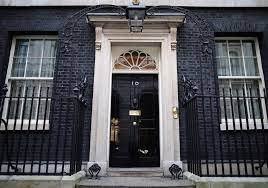
The official residence of British Prime Ministers is number 10 Downing Street. It is in a sidestreet off Whitehall, near the Houses of Parliament.
It was built by Sir George Downing in 1680, and in 1738 George Il offered it to Sir Robert Walpole, who was Britain’s first Prime Minister.
Next door, at number 11, lives the Chancellor of the Exchequer.
The building is much larger than it appears from its frontage. The hall with the chequered floor immediately behind the front door lets on to a warren of rooms and staircases. The house in Downing Street was joined to a more spacious and elegant building behind it in the early 18th century. Number 10 has also spread itself out to the left of the front door, and has taken over much of 12 Downing Street, which is accessed by a corridor that runs through 11 Downing Street – the official residence of the Chancellor of the Exchequer.
The area around Downing Street was home to ancient Roman, Anglo-Saxon and Norman settlements, and was already a prestigious centre of government 1,000 years ago.
The Romans first came to Britain under the command of Julius Caesar in 55 BC. Making their capital at Londinium downriver, the Romans chose Thorney Island – a marshy piece of land lying between two branches of the river Tyburn that flowed from Hampstead Heath to the Thames – as the site for their early settlement.
These Roman settlements, and those of the Anglo-Saxons and Normans who supplanted them, were not very successful. The area was prone to plague and its inhabitants were very poor. A charter granted by the Mercian King Offa in the year 785 refers to “the terrible place called Thorney Island”. It took royal patronage to give the area prestige. King Canute (reigned 1017 to 1035) built a palace in the area, and Edward the Confessor (reigned 1042 to 1066) and William the Conqueror (reigned 1066 to 1087) maintained a royal presence there. The position of Westminster (as the area became known) as the centre of government and the church was solidified following the construction of the great abbey nearby, on Edward’s orders.
Credit : Gov.UK
Picture Credit : Google




